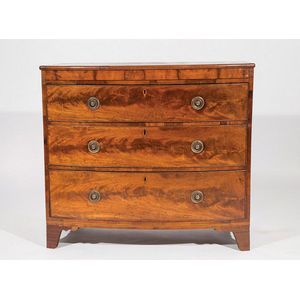George III Mahogany Chest of Drawers
You must be a subscriber, and be logged in to view price and dealer details.
Subscribe Now to view actual auction price for this item
When you subscribe, you have the option of setting the currency in which to display prices to $Au, $US, $NZ or Stg.
- Drop Handles - In furniture of the late 17th and early 18th centuries, small metal drop handles were often used, frequently in a pear or tear shape. The back plate, to which the drop was attached, may be either a simple plain circle, or in the form of a star or diamond. These handles have been widely reproduced, and are frequently found on Jacobean and Queen Anne style furniture made after the first world war. Reproduction handles can usually be identified by the inferior quality of the metal used during the 1920s and 1930s, sometimes thinly coated with brass or copper, though modern copies are often of excellent quality.
- Mahogany - Mahogany is a dense, close grained red-coloured timber from the West Indies and Central America. It was first imported into Europe in the the early 18th century and its use continued through the 19th century. It was popular for furniture making because of its strength, the wide boards available, the distinctive grain on some boards, termed flame mahogany and the rich warm colour of the timber when it was polished.. The "flame" was produced where a limb grew out from the trunk of the tree, and this timber was usually sliced into veneers for feature panels on doors, backs and cornices.
Some terms used to describe mahogany relate to the country from which it originally came, such as "Cuban" mahogany, "Honduras" mahogany etc. However unless the wood has been tested the names assigned are more a selling feature, rather than a true indication of the timber's origin. - George Iii - George III (1738 - 1820) was King of Great Britain and Ireland from 1760 to 1820.
- Escutcheons - An escutcheon is a plate, made of brass, wood, ivory or ebony, which fits into or over the h keyhole, to protect the edge of the timber keyhole from damage by continual insertions of the key. As a general rule you would expect these escutcheons to be sympathetic in design to the handles of the piece. From the early 19th century escutcheons were sometimes made from ivory, ebony, bone or contrasting wood, often cut in a diamond or shield shape and inlaid into the front. Ivory, in particular, will tend to discolour with age, and certainly should not show up as brilliantly white.
This item has been included into following indexes:
Visually similar items

A George III mahogany chest of drawers with rectangular top above two short and three long drawers, 78 cm high, 93 cm wide, 49 cm deep

A Victorian bowfront chest with lift up top above three drawers and shaped apron. Height 106 cm. Width 127 cm. Depth 57 cm

An Eighteenth century Georgian oak chest of five drawers with dressing shelf. Height 93 cm, width 95 cm, depth 53 cm

Regency mahogany bowfront chest of three long drawers on bracket feet.
